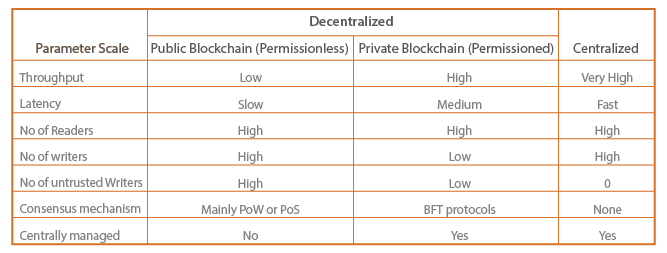BFT as the name suggest stands for “Byzantine fault tolerance”. It is a popular protocol in distributed computing. It has been a very popular model for consensus algorithm where it aims to reduce the scalability issues
BFT not only offers an efficient consensus protocol, but also works towards providing better latency and throughput will less usage of computation, storage and bandwidth
The success of basic BFT model lies in setting up of homogenous validator nodes that can tolerate f out of n faulty nodes
The transactions are sent for validation to the consensus nodes. The leader node, then validates the transaction, decides and spread the information to all the connecting nodes
The High level Variations of BFT
- Parallel BFT:
As the name suggests, it works through parallel request processing by appointing multiple leaders rather than relying on a single leader as in case of basic BFT protocol. Thereby achieving higher throughput and scalability
- Asynchronous BFT:
The Asynchronous BFT model is best suited for Blockchain implementation. The messages are delivered to different nodes with no timing assumptions. Each message is encrypted using the public key encryption method of cryptography. Regardless of how network conditions fluctuate, the throughput tracks available network bandwidth. Thus, providing better throughput, high security. Due to batch processing, it creates a multi-level pool of nodes, there by providing better efficiency in reducing cost.
Back to BFT and how it’s linked to blockchain
Byzantine fault tolerance is a way of defining a system that deals or tolerates the failures as defined in Byzantine general’s problem
It allows no restriction not makes any assumptions about the node behavior can exhibit (e.g. a node is the system can pass or generate any arbitrary message while actively participating within the network)
Thus, making it as most difficult cases of node failure.
Blockchain linkage
Blockchain in broader terms is distributed ledger bookkeeping system which is not controlled by any centralized party. Due to the data or values stored in the ledger, it makes it more susceptible for fraud or any users who can have access might act as bad actor gaining huge financial incentives and try to cause faults within the network for personal economic gains and try to cause faults within the system
Because of the above stated problem, the solution to Byzantine fault tolerance for blockchain becomes more critical.
If BFT is not implemented in Blockchain, the chances of peer node able to transfer false transaction within the blockchain network make it susceptible to blockchain reliability.
And with no centralized authority to monitor, makes the situation beyond damage repair.
Significance of BFT in Blockchain
Since Blockchain is a decentralized ledger having no control any central authority bodies, value stored in these ledgers if faults can be created will have huge economic gains to the hackers.
BFT is one of the most studied concepts in distributed systems. Its integration via various BFT algorithms makes it to be one of the key components of cryptocurrencies.
Comparative measurements:

Conclusion: The study shows that For the Private Blockchain network, the number of people able to access is very low based on the conditions and high security. Because of the same reason the accessibility by untrusted sources are greatly reduced. Thus making Private Blockchain a more secure and trusted network.
As more and more platforms try to innovate and develop consensus models within blockchain systems, coming up with advance BFT algorithms will be important in keeping up the network integrity and trustless nature.
At MagicBlockchainqa, we are helping the global FinTech companies to test and implement their Blockchain model successfully. Our highly skilled Blockchain QA team offer end to end product testing on Blockchain network and smart contracts. With in-depth domain understanding, can help in automating the regression test bed for easy and production-ready solution.
To know more about our FinTech focused BlockChain please contact us at www.magicblockchainqa.com.



